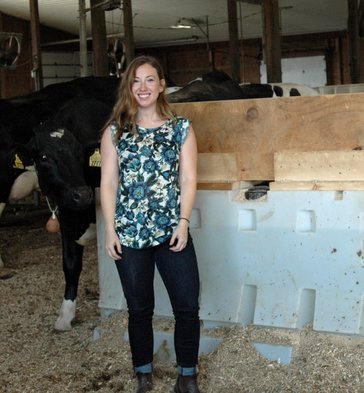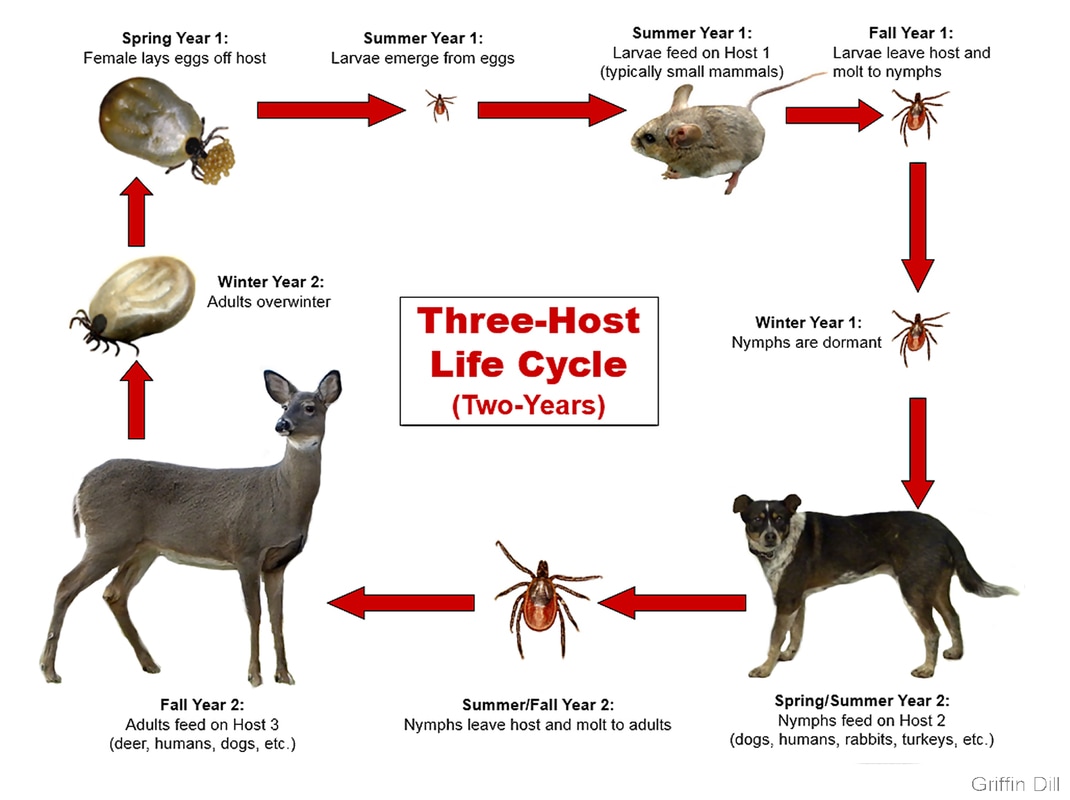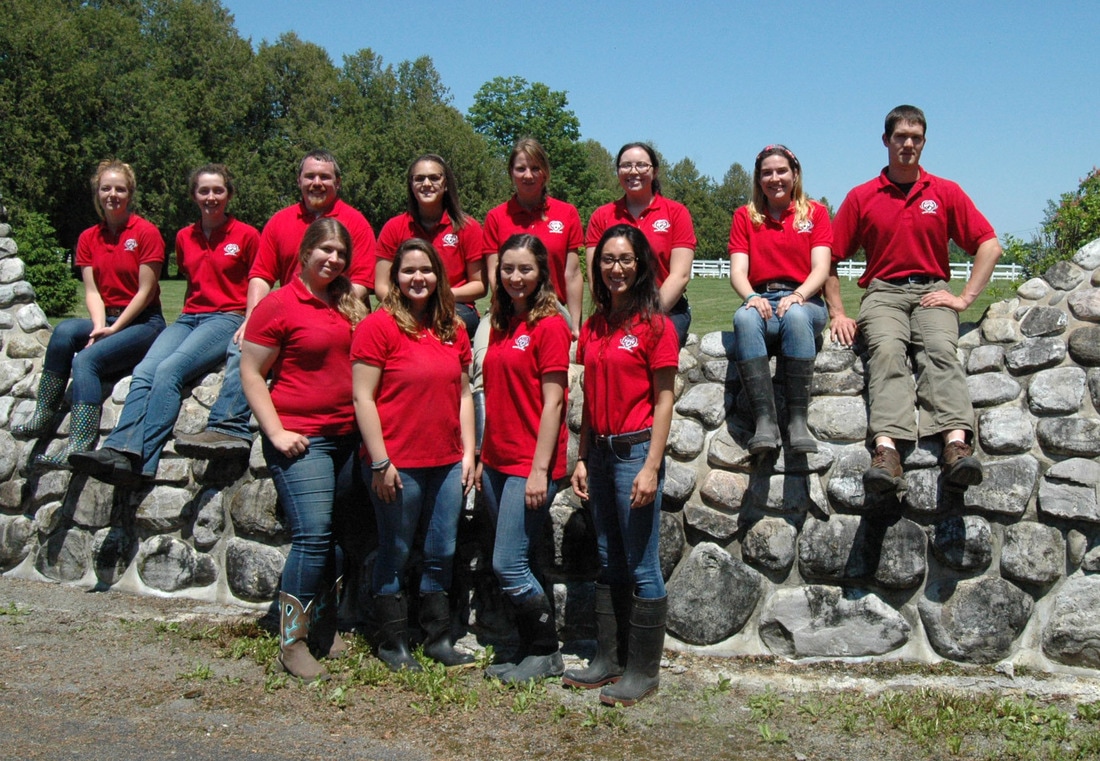 Melissa Stone discusses ticks and Lyme disease during a June 15 talk at Miner Institute. Melissa Stone discusses ticks and Lyme disease during a June 15 talk at Miner Institute. As much as I would prefer to bury my head under my pillow and pretend that ticks don’t exist and don’t present a risk to my family, I know that awareness is powerful and I have already pulled a tick off my 5-year-old daughter’s scalp, so I have vowed to arm myself with information. On June 15, we were fortunate to welcome Melissa Stone, a Ph.D. student in the Department of Biological Sciences at SUNY Albany for a talk. Melissa is enthusiastic about ticks and I am grateful for that. Personally, I am repulsed by them, but am pleased that someone is willing to study them and tell the rest of us how to be safe. Melissa’s research focuses on the ecology of Lyme disease and the evolution of Borrelia burgdorferi, the causative agent of Lyme disease. Ticks are parasitic arachnids and feed on the blood of small mammals, birds, and occasionally reptiles. There are four types of ticks that have been found in New York State that can transmit diseases to humans – the deer tick; the American dog tick; the Lone star tick; and the woodchuck tick. The deer tick is the only tick that carries the bacteria that transmits Lyme disease and is prevalent in most areas of the state. There are at least a dozen other diseases that can be transmitted by ticks, though Lyme disease is the most common in NY State. If Lyme disease is caught early, it is typically treated successfully with antibiotics. Ticks do not fly or jump, but some ticks, like the Lone star tick, actually crawl toward their host when they sense them in the vicinity. For example, Melissa says, “if you were to go for a walk in the woods and stop to tie your shoe and take a drink, these ticks could catch up to you from many meters away. But, if you were to walk away from them before they got too close, they probably wouldn't be able to catch up.” Most ticks quest – cling to leaves or grass with their first set of legs outstretched and wait for their host to pass. Ticks are “vectors” which can transmit diseases from animals to humans. They can transmit bacteria and infections that they’ve picked up from any previous hosts they have fed on. Ticks tend to live in shady, grassy areas but also in lawns and gardens and at the edge of woods and around old stone walls. They like dark, moist protected areas and will seek out those areas once they find a host. Ticks will crawl into belly buttons, the base of the neck and scalp, behind ears, armpits, etc. Protect yourself Ticks are most active in the spring, summer, and fall. It certainly is not practical to avoid being outside during the most desirable times of the year for outdoor activities! To help protect yourself, wear light-colored clothing so that ticks are easier to spot. Tuck pants into socks and shirts into pants, to give ticks less access to your exposed skin. Do daily tick checks on yourself, your children and pets. Stay on marked trails when hiking and try to walk in the center of the trail. Tie back long hair when gardening and doing activities outdoors that would allow ticks to crawl up your hair and onto your scalp. Take a bath or shower after spending time outside to help wash off any ticks that haven’t yet attached and to more easily find any other ticks. Use EPA-registered insect repellent. Repellents with 20% or more of DEET can be applied to skin and clothing. Picaridin can also be applied to both skin and clothing and is nearly odorless, so may be a good choice for someone who is sensitive to strong smells. Permethrin can be applied to clothes, shoes and camping gear, but should not be applied to skin. The New York State Health Department advises that repellents should be stored out of the reach of children and children should not apply repellents to themselves. Ticks are incredibly tiny, which makes finding them more challenging. Young deer ticks are about the size of a poppy seed and adult deer ticks are roughly the size of a sesame seed. Engorged ticks can weigh 200-300 times more than they did before they started feeding. An engorged tick is much easier to see, but has had more time to potentially transmit disease while feeding. Tick removal There are a variety of tick removal tools on the market, but the Centers for Disease Control and the New York State Department of Health recommend using a pair of pointed tweezers. I used a tick key to remove the tick on my daughter and thought it worked great. When removing the tick, try to grasp the tick as close to its mouth parts (where it is attached to the skin) as possible. Pull firmly and steadily upward. Don’t squeeze or twist the tick as that may actually detach the body from the mouth parts. Clean the bite site with rubbing alcohol or hydrogen peroxide and monitor the site for 30 days. There are videos circulating on social media promoting the use of peppermint oil to get ticks to detach. This action will agitate the tick and cause it to salivate more, potentially releasing more bacteria before ultimately detaching. Other common, but potentially dangerous, tick removal methods include using alcohol, fire, or Vaseline. Similar to the peppermint oil, these methods cause the tick to regurgitate its gut contents, including any pathogens it might contain, which can infect the host, even if the tick had not yet been attached long enough for the usual biological transmission. Lyme disease symptoms Between 60 and 80% of people who have Lyme disease get a bulls-eye rash, called erythema migrans. The rash appears at or near the site of the tick bite, usually within three days to a month of the bite. The rash is a very good indicator of Lyme disease. If you get the rash or any other symptoms of Lyme which include joint pain, chills, fever, and fatigue, you should seek medical attention. As Lyme disease progresses, severe fatigue, stiff neck, tingling or numbness in the arms and legs, or facial paralysis can occur. If Lyme disease is treated with antibiotics in the early stage of the infection, patients usually recover fully. For more information about ticks and Lyme disease, you can visit the New York State Department of Health website at www.health.ny.gov or contact the state or county department of health in your area.
1 Comment
 A curious cow looks on as Kate stands in front of the calving blind that she helped to design for her study. A curious cow looks on as Kate stands in front of the calving blind that she helped to design for her study. Kate Creutzinger will spend the coming year at Miner Institute helping to oversee a collaborative research study that will look at stocking density and the utilization of a calving blind within a commercial dairy farm setting. The study is funded by the United States Department of Agriculture (USDA) and is a collaborative project between Miner Institute, University of Tennessee Knoxville, and The Ohio State University, where Kate is working toward a Ph.D. with Dr. Katy Proudfoot. Kate grew up in Mason, a suburb of Cincinnati, OH. She grew up with horses and participated in 4H. She earned an animal science degree from The Ohio State University and thought she wanted to go into pharmaceutical sales. She did undergraduate research in dairy behavior with Dr. Proudfoot and started to take large animal production classes and “fell in love with the process,” she said. In 2014, Kate started a masters program in beef cattle behavior at the University of Saskatchewan in Canada. There she learned about hair cortisol as a measure of stress in beef cattle. “I loved it,” Kate said of the Canadian province known as the land of the living skies. The two largest agricultural outputs in Saskatchewan are canola and flax, which are yellow and purple, respectively. The fields were beautiful, she recalled. After completing her masters, Kate stayed on in Saskatchewan for about six months working at the Prairie Swine Center, a non-profit swine research facility as a research assistant in the ethology department. “I like pigs, they are highly intelligent animals,” she said but wishes to move forward with her career in the dairy industry. That experience though, “has given me a broader range of knowledge to apply,” she said. Ultimately, Kate said, she’d like to work in industry. She said that she loves research and working with animals, but there is so much good research out there being conducted and that information needs to be effectively distributed to farmers so that it can be utilized. She would like to work for a company like Cargill in their welfare department helping farmers to make the best management decisions for their farm to adapt to changing regulations. Kate moved to Chazy to start her work here at Miner in early April. She says that she likes it here. “It’s beautiful. The facilities are great to work in.” She said that she is excited to get her project underway in June. Kate said that she is interested in looking at natural behaviors and how those behaviors can be modeled in a commercial setting. “The transition period is so critical,” she said. The animals “are compromised and susceptible to disease.” In spring 2018, Kate will return to Ohio to finish up her classes, do the data analysis and write up the report for her project. In the meantime, while not working, Kate hopes to enjoy some hiking and Cross-country skiing in the North Country. Our 12 summer interns have spent the last few weeks getting acquainted with Miner Institute and delving into the hard work that will consume the next 10 weeks of their lives. They also survived three days of our annual Farm Days for Fifth Graders event where we hosted 500 area fifth graders, teachers, and parents on a tour of the farm, educating them about agriculture, Miner Institute and Heart's Delight Farm. In honor of June being Dairy Month, we took an impromptu poll of our interns, asking what is your favorite dairy product? The result: 6 votes for cheese, 5 votes for ice cream, and 1 vote for fluid milk! We are so pleased to have such a great group who will undoubtedly be a benefit to the industry as they continue their careers. Back row L to R: Lauren Offutt, Colorado State University student in the Summer Experience in Equine Management program; Sam Berube, SUNY Cobleskill student in the Summer Experience in Equine Management program; Ben Henrichs, Southern Illinois University student in the Summer Experience in Agricultural Research program; Breanna Watson, Mississippi State University student in the Summer Experience in Agricultural Research program; Christina Markunas, Michigan State University student in the Summer Experience in Farm Management program; Megan Miller, Clemson University student in the Summer Experience in Equine Management program; Gabbie Green, University of Tennessee student in the Summer Experience in Agricultural Research program; and Kyle Pimemtel, University of New Hampshire student in the Summer Experience in Equine Management.
Front row L to R: Karen Bonhomme, Plattsburgh State University student in the Summer Experience in Equine Management program; Courtney Hoff, Cornell University student in the Summer Experience in Agricultural Research program; Abby Maucieri, Virginia Tech student in the Summer Experience in Farm Management program; and Mayumi Marzolf, University of Missouri student in the Summer Experience in Farm Management program. |
Archives
March 2022
Categories
All
|

1034 Miner Farm Rd. Chazy, NY 12921
www.whminer.org
518-846-7121


 RSS Feed
RSS Feed